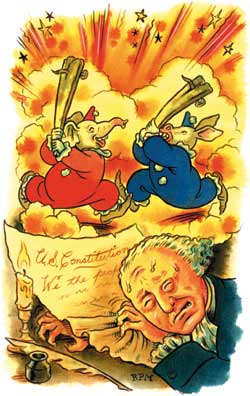
It’s manifestly obvious. The last thing the United States needs is more politics. Or so the American people, who hate politics, believe. And on this point, alas, they are very wrong. One reason citizens dislike politics is that the political system doesn’t work terribly well, but it doesn’t work well because we have neglected to create wise rules to govern it. We can place the blame for this deficiency squarely on the shoulders of the Founders.
In so many respects, today’s political system is broken, and there is currently no reasonable prospect of fixing it. Our schedule of presidential primaries and caucuses is a front-loaded mess, and the Congress, the parties, and the states refuse seriously to tackle its reform. The Democrats are currently tinkering at the edges of reform, just as the Republicans attempted to do in prior years, but little will come of it because of the powerful interests with heavy investments in the status quo. Our scheme of campaign financing incorporates the worst of several worlds, and with each election cycle the process deteriorates further. Our partisan procedure for drawing legislative districts enforces vicious polarization rather than encouraging moderation and compromise. Are these calamities our fault? Certainly. But all these disasters can be traced back to the writing of the Constitution—not so much what was included in the text, but some items foolishly or thoughtlessly excluded from it.
The Founders preferred to think of themselves as statesmen, not politicians, and in the statecraft of their times there was remarkably little formal role for politics. Even more than in the current day, politics was viewed as a disreputable business, and the perfidies of “factions” (the Founders’ name for political parties) were detested and dreaded. George Washington famously warned the new nation against them in his Farewell Address:
However combinations or associations of the above description may now and then answer popular ends, they are likely, in the course of time and things, to become potent engines, by which cunning, ambitious, and unprincipled men will be enabled to subvert the power of the people and to usurp for themselves the reins of government, destroying afterwards the very engines which have lifted them to unjust dominion.
But as the years rolled by, even during Washington’s own administration, most of the Founders came to understand that politics and its institutions were necessities for a successful Republic. Adams and Jefferson helped to create rival political parties. Their electoral college deadlock in the 1800 presidential contest led to a constitutional amendment that acknowledged the inevitable political relationship between the president and vice president. Citizens grew restive at elite rule and began demanding the opportunity to cast popular ballots for president to instruct their electors. And the American system, in fits and starts and the occasional piecemeal constitutional adjustment, adapted to include these political changes.
The fundamental problem, though, has never been corrected. The Constitution was written by the Founders when they had not yet realized the vital necessity of politics and parties in the process of our elections. Further, the enormous transformation of politics from the part-time avocation of public-spirited gentlemen to the multibillion-dollar enterprise of electoral institutions in a rich, diverse, continental Republic has not been matched by constitutional adaptation. The absence of modern politics in the Constitution—from the structure of presidential selection to the manner of congressional elections to some critical aspects of electioneering, such as redistricting and campaign finance—has caused no end of difficulties, which can only be corrected by the inclusion of thoughtful provisions in a new twenty-first-century Constitution. It is long past time to do so.
Critics of this constitutional approach may insist that the political inadequacies of our system are best handled through statutory means, the better to make adjustments as needed from time to time. And partly, this point of view has merit. The constitutional provisions on the political system should be kept only as specific as absolutely required to cure the ills discussed here. Congressional and state statutes—the regular lawmaking process in the various legislatures—can supplement mandates in the Constitution.
However, the chances for serious, widespread political reform at this late date are virtually nil without constitutional prodding. Yes, a state here or there may enact a useful reform plan for a piece of the puzzle. But the nation is desperately in need of widespread change to and dramatic updating of the political system. Entrenched interests would fight and stop most or all of the reforms outlined in this essay. The United States now has a massive superstructure of essentially untouchable procedures and traditions with powerful beneficiaries—incumbents, wealthy groups and individuals, even specific states (think Iowa and New Hampshire in the presidential selection process).
It will take a new revolution to modernize America’s ossified politics. It will take a revolution generated by an engrossing national debate—the kind of debate that can only be engendered by the writing of a new Constitution. Enough with the Band-Aids! An end to feeble efforts at reform in one state or region! So much for the occasional initiative or referendum that usually fails due to campaign spending by special interests that would be damaged by change in the national interest. We the people need to confront all the problems at once, to seek a comprehensive solution that will be as permanent as a Constitution can promise.
Let’s start by overhauling the insane methods we employ for picking a president.
Of Parties, Presidential Politics, and the Quadrennial Orgy
Once avoided in their entirety by the Founders and the Constitution, political parties have become the sine qua non of American democracy. This was obvious by the time of Andrew Jackson, if not before. Even prior to his presidency, Woodrow Wilson declared parties to be utterly essential to the functioning of both elective branches—the institutions holding together the Government of the United States in the face of so many internal, dividing checks and balances:
[G]overnment is not a machine, but a living thing. . . . No living thing can have its organs offset against each other as checks, and live. . . . The way in which the several branches of the federal government have been separately organized and given efficiency in the discharge of their own functions has only emphasized their separation and jealous independence. . . . It is for that reason that we have had such an extraordinary development [outside of the Constitution] of party authority in the United States and have developed outside the government itself so elaborate and effective an organization of parties.[The political parties] are absolutely necessary to hold the things thus disconnected and dispersed together and give some coherence to the action of political forces. [Emphasis added.]
Wilson also suggested the government was subject to Darwinian evolutionary forces, and he was correct again. Over many decades, the parties have evolved to meet the organizational needs of government. Along the way, though, the constitutionally ungoverned parties have also changed to serve their own needs better—and those selfish purposes have begun to override those of the citizenry’s. Without any federal constitutional guidelines and strictures, parties have become state-based, even though they serve the highest of national purposes, such as the nomination of presidents. The fifty state political parties on each side (Democratic and Republican) squabble among themselves, initiating internecine battles about who can go first, and second, and third, in presidential selection every four years. In doing so, they promote and serve individual state interests over the national interest. The federal Constitution has been preeminent over the state constitutions since the days of Chief Justice John Marshall, but not so among the political parties, which live in a no-man’s-land—a Wild, Wild West—in law and practice. Darwinian evolution is fine for the origin of species, but it is past time for the essential political institutions called parties to be governed by some sort of federal intelligent design. Only the Constitution can achieve this aim.
If any ongoing disaster can prove the point, then surely it is the quadrennial orgy of the presidential primary process.
Imagine that a convention of clowns met to design an amusing, crazy-quilt schedule to nominate presidential candidates. The resulting system would probably look much as ours does today. The incoherent organization of primaries and caucuses, and the candidates’ mad-dash attempts to move around the map, would be funny if the goal—electing the leader of the free world—weren’t so serious.
In 1968 there were seventeen state presidential primaries, a manageable number spread out from March until June. The voters could focus on their task, and often there was enough time between primaries (a couple of weeks or so) for midcourse corrections in the selection of a party nominee. In 2004 there were forty primaries, not counting the ones in DC and Puerto Rico, and for “Americans abroad,” stretching from January through June—a six-month period of intense politicking, preceded by at least a year of equally intense, headline-grabbing maneuvering by the candidates.
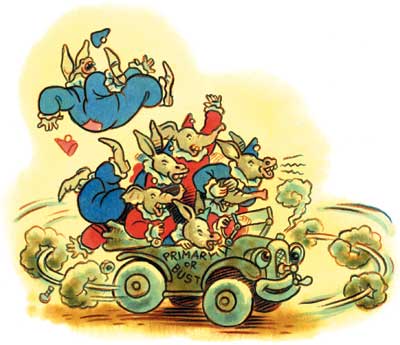
To make matters worse, in a phenomenon called front-loading, the states are mainly rushing to the front of this already-elongated calendar, in order to maximize their impact on the choice of the party nominees. While only one state had a primary or caucus in January or February of 1980, by 2000 that number was nine, and by 2004, nineteen. In the presidential system, the old axiom that “the first shall be last, and the last shall be first” doesn’t apply. With only a couple of modern exceptions (1976 on the Republican side in the Gerald Ford–Ronald Reagan battle and 1984 in the Democratic struggle between Walter Mondale and Gary Hart), the presidential nominees have been known well in advance of the party conventions, and usually the first handful of primary and caucus contests determine the winners.
Few want to go back to the bad old days when party “bosses” chose presidential candidates in smoke-filled rooms. (Yes, the bosses did well by selecting nominees such as Franklin Roosevelt, but they also picked the disastrous Warren G. Harding.) Primaries and caucuses are now fundamental to our conception of popular democracy in presidential selection. But there is such a thing as too much popular democracy, if it is hopelessly disorganized.
Every attempt to bring order out of chaos has failed, and there have been many attempts to do so. In 2000, Republicans tried to pass a plan to give states incentives to hold later primaries and caucuses in an attempt to slow front-loading, but the plan failed to pass. For 2008 the Democrats have been hoping to bring about some reasonable reordering of the early contests by designating a handful of representative states to go first, but the attempt to dilute the impact of Iowa and especially New Hampshire has been falling apart.
A good-sized piece of the problem can be labeled “Iowa and New Hampshire.” These two states seem to assume that the Constitution guarantees that they should go first, but a close reading of the text finds no such clause. The New Hampshire primary has been around since 1920, and it has arguably been very influential since 1952, when it played a role in both the decision of President Truman not to seek reelection and Dwight Eisenhower’s successful quest for the GOP nomination. New Hampshire reprised its 1952 king-killing act in 1968, when Minnesota senator Eugene McCarthy came within a few percentage points of President Johnson in the Democratic primary, leading in part to LBJ’s decision shortly thereafter not to seek another term. The Iowa caucus has only played a role since 1968, and its true national debut came in 1972, when George McGovern scored well there on his way to a surprise, ill-fated Democratic nomination. Just four years later, the Iowa caucus propelled a little-known former Georgia governor, Jimmy Carter, to the Democratic nomination and the presidency, assisted also by Carter’s subsequent narrow victory in New Hampshire. (Remarkably, Carter succeeded grandly while capturing less than thirty percent of the vote in Iowa and New Hampshire.)
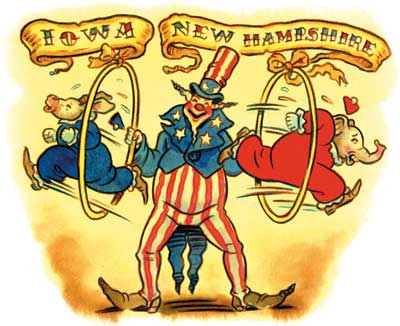
The presidential selection process is a bonanza for both the Hawkeye and Granite States. It is an industry that produces tens of millions of dollars in spending from the campaigns. Candidates and their staffs often practically move into these states, and they bring thousands of reporters with them over time. The television and radio stations, the hotels, and the restaurants of Iowa and New Hampshire make a killing off of the business generated by their claim to political supremacy. Moreover, all the candidates—and thus the eventual president—learn about their problems and needs, and make lots of promises to fix this and spend that and support ethanol. The presidential selection process is a gravy train for Iowa and New Hampshire, and they know it. The citizens of the leadoff states take their job as presidential screeners seriously, but then what citizens given this important task would not? The presidential candidates fully understand the game they are playing, and the absurdity of it. For example, Michael Dukakis, the 1988 Democratic presidential nominee, had this to say about Iowa in 2001:
I spent 85 campaign days in the state of Iowa alone. Now, Iowa is a great state . . . and they did very well by Mike Dukakis. But, 85 full campaign days in one state . . . really doesn’t make a hell of a lot of sense, does it?
The truth is that Iowa and New Hampshire have a franchise they are determined to keep at all costs. New Hampshire even has a law that requires its secretary of state to do whatever is necessary to keep its primary first, and Secretary William Galvin has threatened, if needed, to move the New Hampshire primary back into the calendar year before the presidential election to fulfill his mandate. No doubt Iowa would do the same. And we think the process takes too long already?
Without a constitutional answer, there is simply no remedy to a situation that deteriorates every four years. Try as they might, the political parties cannot orchestrate a fix. In the end, they can only punish a recalcitrant Iowa and New Hampshire in minor ways, perhaps by cutting the size of their convention delegations or giving the delegates bad hotels and poor seating at the party conclaves. And that assumes the national parties have the will to do anything. After all, Iowa and New Hampshire are in catbird seats since both are now swing states in the November 2008 presidential election, and their collective twelve electoral votes can easily be the difference between victory and defeat in this closely divided era.
In addition, Congress arguably has no effective power to intervene in a state-based, party-centered nominating process, and even if the courts held that it did, Congress would be highly unlikely to step into that briar patch. The senators and representatives from Iowa and New Hampshire would be willing to do anything to stop reform, quite possibly with assistance from colleagues who would see their own presidential ambitions at stake. A senator who becomes a hero in Iowa and New Hampshire for saving the caucus and primary would be halfway to a presidential nomination! And realizing this, most or all of the senators with presidential aspirations would jump to back the Iowa/New Hampshire status quo—and it’s a rare senator who doesn’t get up in the morning and see a president in the mirror.

No, the only possible, comprehensive answer is a constitutional one. In the twenty-first century we the people need to do what the Founders didn’t even consider doing in their pre-party, pre-popular-democracy age. The guiding principle should be one that all citizens, in theory, can readily embrace: Every state and region ought to have essentially an equal chance, over time, to influence the outcome of the parties’ presidential nominations, and thus the selection of presidents. Why should two small, heavily white, disproportionately rural states have a hammerlock on the making of the president? Together, Iowa and New Hampshire are a mere 1.4 percent of the US population, and about 40 percent of their residents are rural—double the national proportion. Their average population of African Americans and Hispanics/Latinos is 3.6 percent, while the nation as a whole is 24.6 percent minority. Even if one assumes, incorrectly, that the two states are somehow representative of their Northeast and Midwest regions, the South and West (containing 55 percent of the country’s people) are left entirely out of the critical opening window of presidential selection.
Beyond the equal-influence-over-time rule, the presidential selection process also ought to enable the states to spread out the contests over several months, thereby reducing front-loading and the low voter turnout that comes with it. In most recent cycles, the nominations have been all but decided by the first few weeks of voting, leaving large majorities of voters and states effectively disenfranchised. In 2000, for example, both Vice President Al Gore and Governor George W. Bush had all but cinched his party’s nomination before thirty-three states, including many of the largest, had even voted. Understandably, this fact led an alienated public to tune out the process before they could become engaged and learn about all the men and women who would be president. Also in 2000—the last time both parties had multicandidate, highly competitive fields running for the presidency—a mere 17.7 percent of the adult population turned out to vote in all primaries and caucuses, in both parties and all states combined. This is a miserable showing, and it also contributes to the control of the nominating machinery of both parties by those well over on the left (Democrats) and the right (Republicans). The majority of the public that is gathered around the ideological center has been the first to become discouraged and disconnected in the past few decades, furthering the polarization that bedevils American politics. The construction of a nominating process that is inclusive and rational may contribute a great deal to broadening the level of participation in the primaries and caucuses.
That nominating process ought also to be focused, and compressed into the four months leading up to the party conventions. Presidential politics now takes fully one-fourth of a president’s four-year term, and with the acceleration of front-loading, it soon may consume even more of it. Not only is this bad for the presidency as an institution, it causes the electorate to tire of the never-ending political campaign. It should be possible to create a system that flows from the first primaries and caucuses in April directly into August party conventions, and then into the Labor Day kickoff for the autumn general election. Not only is this not rocket science, it doesn’t even qualify as elementary mathematics. It is easy, if the will and the means are present. The electorate must supply the will, and the Constitution should outline the means.
There have been dozens of proposals to revamp the primary scheme, though none has been offered as a constitutional fix. Clearly, that is because the Constitution currently ignores the politics of the system almost entirely and because a constitutional insertion—virtually written in stone—would have to be as fair and foolproof as possible. Submitted for your consideration is the Regional Lottery Plan, which this author has tinkered with for many years in his ivory tower.
The Regional Lottery Plan for the New Constitution
The Congress should be constitutionally required to designate four regions of contiguous states (with contiguity waved for Alaska and Hawaii, and any other stray territories that might one day become states). The regions would surely look something like the ones on the map below, with natural boundaries denoting the Northeast, South, Midwest, and West. These regions have about the same number of states: Northeast (twelve states plus DC), South (thirteen states), Midwest (twelve states), West (thirteen states). All of the states in each region will hold their nominating events in successive months, beginning in April and ending in July. The two major-party conventions would follow in August. This schedule, all by itself, would cut three months off the too-long process currently prevailing in presidential years.
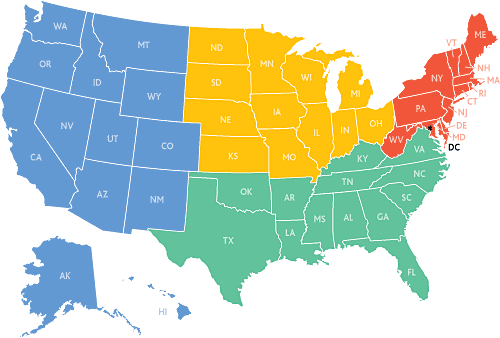
The presidential nominating system would still be state-based, so each state would be free to choose any date it wished within the region’s month, and further, it would be free, as currently, to choose either the primary or the caucus method of selecting delegates. Of course, it is possible that all the states in a region will try to front-load their contests on the first possible day, but that actually makes little sense, except perhaps for the first region in the series. Even in that first region, a state may have more influence coming later in the month, perhaps standing alone on a particular day—a situation that will encourage presidential candidates to spend time and money in the stand-alone state. After all, the postprimary headlines will belong solely to the candidate who wins that stand-alone state. If there are ten states on a particular day, the headlines as well as the candidates’ time and money will be split ten ways. Note, too, that the regional system concentrates the candidates within a single region for a month. They will have a better opportunity to get to know the problems and peoples of the region and its states, and the geographic proximity of the campaigning will cut down on the wear and tear on the candidates, to some degree anyway.
But how would the order of the regions be determined? In many cases, there would still be a bonus in going first. The establishment of a US Election Lottery, to be held on New Year’s Day of the presidential election year, is the answer that yields fairness and adds an element of excitement to the beginning of a presidential year. One of the nation’s famous lottery machines with the pop-up Ping-Pong balls will finally find a purpose beyond bestowing untold riches on people who can’t handle it. Four color-coded balls, each representing one of the regions, will be loaded into the machine, and in short order—the length of a TV lottery drawing—the regional primary order will be set. Since none of the candidates would know in advance where the political season would begin, part of the permanent presidential campaign would be dismantled. Even a very wealthy candidate wouldn’t waste the money necessary to organize all fifty states in advance, and the four-year-long homesteading in Iowa and New Hampshire would be gone forever. Much more importantly, the law of averages would give every state and each region, over time, the precious opportunity of going first. The new constitutional provisions would repeal the nonexistent right to go first that Iowa and New Hampshire have appropriated for themselves.
Another benefit of the Regional Lottery Plan would be the reasonable spacing between contests, potentially allowing candidates to recover from setbacks in one region and to regroup for the next set of contests. Today’s front-loading nearly ensures that the entire competition for the party nominations is over within a few weeks, whereas under the lottery plan, regional pride and loyalties might demand that the race continue through two or three, and maybe all four, sections of the nation. The press and voters in each region would certainly agree on this critical matter, demanding their fair share of attention.
In order to enhance its effectiveness, one additional element should be added to the lottery plan. Even though the four regions have their usefulness as voting divisions, the United States is a continental country, and each region is still large and expensive for any candidate’s travel and advertising. Personal campaigning would be diminished, compared to what now happens in Iowa and New Hampshire. Therefore, it would be appropriate to add a second lottery on January 1. The names of all states with four or fewer members of the US House of Representatives (at present, twenty states) would be placed in a lottery machine, and two balls would be selected; I exclude the island territories, which are far-flung and irrelevant to the November presidential outcome, since they have no electoral votes. The District of Columbia, with three electoral votes, should be included, however, and this would mean twenty-one jurisdictions would have a chance to be selected in the second lottery. The two small states (or DC) with relatively low populations would precede the regional contests and be held on or about March 15—at least two full weeks before the initial contests would begin in the first region. These two states would be free to stage a primary or a caucus, and the candidates would be free to participate in one, both, or neither. As a practical matter, most candidates would choose both, unless a prominent candidate hailed from one of the leadoff states. Traditionally, a home candidate is deferred to and nearly unopposed for the state’s delegate votes. Of course, the other party can still have a full-fledged fight in the state’s primary or caucus.
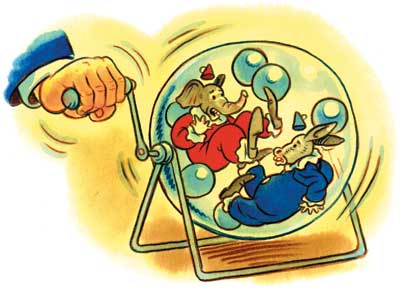
No doubt, all the candidates would rush to these leadoff states right after the lottery on January 1, and they would have two and a half months to campaign. But there would again be no permanent, four-year campaigns there, and personalized, one-to-one campaigning would be a large part of the effort. In other words, the two states would offer all the advantages of Iowa and New Hampshire, without having to always be Iowa and New Hampshire. Additionally, the guarantee of at least two weeks of decompression after the leadoff states gives voters in the first region a chance to evaluate the results and reevaluate the winners—and possibly to make different choices. The present eight-day window between the Iowa caucus and the New Hampshire primary often creates unstoppable, unthinking momentum for the winner of Iowa, and a double winner of Iowa and New Hampshire is practically crowned the party’s presidential nominee before any of the other forty-eight states have their say. Under the new plan, this would no longer be likely given the non-front-loaded, rationally spaced, regional primary system.
In sum, the Regional Lottery Plan will achieve simultaneously many good things for a selection process that currently makes little sense. The election campaign will be shortened and focused, a relief both to candidates and to voters. All regions and states will get an opportunity to have a substantial impact on the making of the presidential nominees. A rational, nicely arranged schedule will build excitement and citizen involvement everywhere in the country, without sacrificing the personalized scrutiny of candidates for which Iowa and New Hampshire have become justly known. And all of this can only come about by putting politics in its proper place—in the American Constitution.






